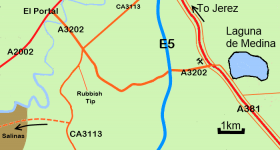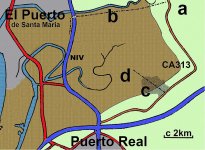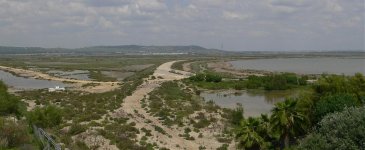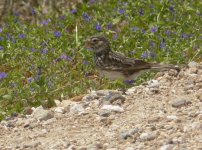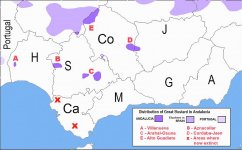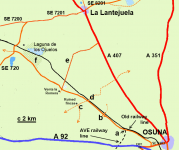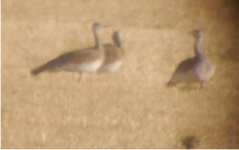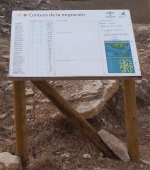We're back in Alcala de los Gazules for four weeks with birding initially limited to what can be seen around the village – well our terrace - early and late in the day. We're at the top of a steep hill in the centre of Alcala and walking far in this heat (35+ºC) is something to be avoided. Hence until we get a hire car, all posts, unless explicitly stated otherwise, refer to sightings in Alcala. Hopefully, though, my posts will give you a flavour of what you can see with very lazy birding in this part of the world.
We arrived late on the 10th so had no time to look for birds, even local ones before dark. I was too busy with other things to have much of a scout round on Thursday (11th) morning, besides it quickly got far too hot. Come the evening, though, the heat had relented, but the wind had not so conditions were decidedly tricky if a lot cooler. Even after a few years of regular visits, there's always something of a 'learning curve' to be negotiated on arrival and no where more so when distant raptors are the target. Add to this looking west into the sun and, with the wind still gusting strongly, the birds had forgotten how they were supposed to fly! The crossbow shape of a hunting Pergrine left no doubt and nor did the typically straggling flock of Black Kites. The Lesser Kestrels were more problematical, but were homing in on their usual roost in an old watch tower. No it was those damn micro-shapes snaking and swooping over the distant line of hills that were causing me grief! Facing into the strong Levante (easterly) winds, the birds presented only a head-on profile. Now, this isn't always an impossible angle for confident ID, but with their wings tucked in and hardly moving, any signals that wing shape and flight action might have given were entirely absent. Add to this that they were being buffeted by conflicting eddies which caused them to drop and turn unpredictably, then the picture of an ID nightmare is complete! Even the magisterial Griffon Vultures were in on the joke holding their wings is a quite atypical manner as they bulleted along. . Perhaps, in a day or two I'll do better than 3-4 Griffons, 2 Booted Eagles, a possible Short-toed and an embarrassment of UFOs (or more precisely UFbOp's), but easy it ain't!
After a late night – this is the week of the Alcala Festival - it wasn't until about 8:30 Friday 12th April 2011 that I awoke. I quick foray up on the terrace showed that there was very little avian activity, but by 09:15 Black Kites were beginning to spiral out from their roosts. As the air warmed more and more kites drifted up, but, as so often, by 10:30 or so it was pretty much all over. Some kites straggled south low along the ridge across the valley, but others circled high into the heavens. Beyond these kites, indiscernible with x8 bins, and only barely so with my x27 'scope, there was a legion of tiny circling dots. A conservative estimate suggests something like 600 Black Kites passed through in the space of barely more than an hour. Impressive though this might seem, and it's my highest count for the species from the terrace, the views were all very distant and not a single kite came directly over the house. Not for the first time I found myself wishing that, despite the huge convenience of having a house in the centre of a small village, that we had one on the ridge-line opposite. With better light and less of a wind I also managed to pick up 3 Booted Eagle, a single Short-toed Eagle, ten Griffons and a couple of probable Lesser Kestrels. My closest encounter with the latter came when I swept the outside stairs and found several “kestrel” feathers. Since so many Lessers breed around the house and always 'see off' any 'Common' I'm sure that they all belong to Lessers. Most, though, I'd guess are unidentifiable except, perhaps, one from the mantle. A flock of swift hawked over the house most of which seemed to be Common, but there were at least three Pallids. A clutch or two of Spotless Starlings and the odd Swallow also showed up, but raptor passage had slowed to a near stop (although Liz reported 60 more Black Kites, this time right over the terrace, at around 16:00).
A further vigil between 18:00 and 19:00, by which time the terrace was again in the shade, if still rather too warm for comfort, produced little in the way of birds. A handful of Swallows, a House Martin or two, a small balbo of Griffons on sentry duty and a couple of Booted Eagle. However, a party of 50-60 swifts strafed the house around 18:30, flying low enough to allow me to see that, whilst most were of the Common persuasion, 2-3 were again Pallids; pretty much what I've come to expect here. Flocks of 'medium sized' swifts are rarely made up of more than 10% of Pallids.
So, another late night and another fine concert explains, but hardly excuses, the fact that I didn't get to look from the terrace until 09:00. With scarcely more than a cooling zephyr and a surprising amount of low cloud the birding from the terrace had a very different feel this morning. Unlike yesterday, there was scarcely a bird to be seen other than some local Spotless Starlings. However, by 10:00 a swirling party of swifts came over signalling a brief period of activity – no definite Pallids amongst the 100+ swifts, but the distance, light and viewing angle was far from ideal. However, there were 2-3 Alpines cruising around. Six Booted Eagles diffidently circled down the valley and, as 10:30 approached, the Griffons started their forays. A party of nine came over low enough, but the remainder, 10+ birds, sauntered past high and in singles or loose pairs. A male Lesser Kestrel – or was it more than one bird? - pottered over to inspect the old place, but that was more-or-less it for the morning.
A passing mid-afternoon Scarce Swallowtail – albeit a scruffy one – did allow me to try out my new camera on some wildlife. The camera was a success, but I'm not so sure about the photographer! Thankfully, having got paint and brushes, the afternoon heat had was far too furnace-like to consider actually doing any work. Unfortunately, the same heat made it too hot to comfortably 'bird' even as late late as 19:00. By then a light westerly poniente wind had started to blow (although not enough to deliver any relief from the heat) and it was probably this that accounted for the scarcity of birds – an initial three Booted Eagles right above the terrace as I popped up to have a look suggested more than was delivered. Indeed, I saw no more eagles and only a brace of Lesser Kestrels plus a meagre handful of hirundines until we had a spot of supper at 20:50. Wind direction here is clearly crucial for any visible migration of raptors. A passing Scarce Swallowtail – albeit a scruffy one – did allow me to try out my new camera on some wildlife. The camera was a success, but I'm not so sure about the photographer!
With the wind again negligible, it was an unproductive day birding on the terrace today (Sunday 14th). A single Red-rumped Swallow rocketed through at 09:00 and a couple of Common Swift circled over, but the skies were more-or-less empty. The first raptors were again Booted Eagles (10:30), but this time only three (are they local birds?). With the skies singularly vacant it was hard to ignore the temptation to read a book particularly when its so interesting as 'Here be Dragons' (a fascinating discourse on biogeography by Dennis McCarthy). Hence, I may have missed the first few Griffons, but the first that I saw were at the later than usual hour of 11:50. However, given the paucity of any birds before hand and on through until 13:00, I suspect that I hadn't missed the first sentinels by much. The only other excitement was a single Alpine Swift low with a handful of 'swift sp'. By 13:00 the remorseless tide of shadeless heat had swept across much of the terrace leaving a retreating, shrinking oasis of shade. On a more productive day I'd have moved still further into the remaining shade (is this umbratropism, the opposite of phototropism?) and sat it out. However, with only the odd flittering flock of House Martins for company I headed below stairs. Naturally, it was now too hot to do any of the remedial work I'd got the paint for and, besides, how could I break the local taboo of working on a Sunday?
An afternoon reading the manual for my new Panasonic G3 camera left me as much confused as informed although at least I could now switch off the all-to-easy accidentally activate dedicated video button. Switching it back on is another matter! Come 17:30 I decided that it was time for a recce on the terrace. Even at this relatively late hour, and carefully keeping to the shade, it was a shock to find just how oppressively hot it remained. Over the distant ridge a party of six Ravens buzzed a raptor out of sight before I could 'scope it, but a Common Buzzard later came up from the same general area so that was presumably the bird in question. The second raptor present before I retreated was a single, very distant Griffon. A dozen or so swifts zapped around, fortunately some flew low into the valley where their milky-brown plumage betrayed them as Pallids (2-3 birds max). As House Martins dithered about an unseen, but noisy, flock of Bee-eaters slipped through. Feeling that I'd roasted long enough and as things were very quiet, I evacuated below. A subsequent foray at 18:30 proved that remained pretty much as hot as it had been, but with even fewer birds. Then it was off to meet up with friends for a very pleasant evening meal. Interesting to see how the flocks of Cattle Egret divide into two streams as they pass over their house – most skirting the village to the west, but a few heading east. Clearly my counts from the terrace miss a small, but significant proportion of the birds that come this way.
No surprise that, after a very late night (02:50), I didn't emerge from my slumbers until 10:30 on Monday (15th). Once on the terrace, true to form four or five Booted Eagles promptly floated up and a single Short-toed Eagle headed south followed by a handful of Black Kites - barely identifiable as they slid past the distant bulk of Medina Sidonia. A single circling bird at a similar distance looked suspiciously like Marsh Harrier but is best left unconfirmed. Swifts were up high but included a couple of Alpine. I also heard a scolding Sardinian Warbler and had a trio of Serin pass over - my first since we arrived. Although things were very slow, since it was far less furnace like than yesterday I managed to stay at post until 13:30. This produced a further four Short-toead Eagle (inc. one at faily closer range at last), another three Booted, about 15 Griffons, a Lesser Kestrel and a dark Common Buzzard. Just before mid-day the melodious bubbling of Bee-eaters drew attention to a small flock of c25 birds in the valley below. Giving just enough time for Liz to nip up and see them, the birds then circled off into the sky. By 13:00 things had become very slow indeed, but I hung on for another half hour until the decreasing area of shade and the need for some lunch again drove me below.
It was still uncomfortably warm at 18:30 and, since little was then moving, I didn't resume birding until 20:00. Even then the pickinga were very slim with no raptors about other than a passing Peregrine and the usual evening inspection by Lesser Kestrel (4). Some high flying apus and hirundines were something of a diversion containing a lone Red-rumped Swallow. In these conditions they tested my ability to distinguish Common from Pallid Swift; most were certainly the former, but there might have been some of the latter present too. Then there was the usual crepuscular procession of Cattle Egret. And so to bed – remarkably at 23:00 rather than post-midnight although this is no guarantee that I'll be up earlier than usual!
16th April 2011 and our 36th wedding anniversary – someone around here deserves a medal and it's not me! Retiring to bed early the previous night had clearly done the trick as I was up and on the terrace by 07:50 (and that's 06:50 UK time!). Pleasantly cool and with clear blue skies and only the slightest of light breezes it seemed idylic. However there was little reward in the shape of birdlife; a few passing Swallows and House Martins, chirruping House Sparrows and not a lot else. Actually, those sparrows are a bit of a treat since it's a god few years since I could hope to expect them in the our small garden back in Canterbury. Not a lot happened beteween 08:00 and 09:10, but the clanking of the crane jib above the terrace made me look vertically above me – and there were a swirling mass of swifts. My immediate estimate was of c500 birds – nearly all Alpine Swift – but there were probably far more since they continued to wheel around passing in and out of sight as they slipped behind the wall that shades the terrace. They were joined by a couple of Lesser Kestrels (09:20), but there were very few 'dark' swifts mixed in amongst them. Gradually as the numbers of Alpines waned, more and more 'Common/Pallids' joined the throng. Given that the swifts were very high and mostly giving only a ventral view any chance of picking up (still less confidently identifying) a possible White-rumped Swift was very low, but that didn't stop me looking! Besides, and in contrast, a Little Swift would have been 'do-able'. The first Griffon of the day graced the skies at 10:20 and was followed by a pale morph Booted at 10:35. No more raptors passed over the house by 11:15 although two of the more distant hills now had 9 (7 & 2) wheeling Griffons, two Short-toed Eagles and a lone Booted. However with things to do, mainly ones I wanted to avoid, it was time to depart down to the village.
As feared, I spent a good portion of the afternoon sorting out the smaller bedroom which badly needs painting; by the time I'd finished parts of it badly needed plastering too! Having managed to pick up emails from the 'internet cafe' in the village I also spent a good deal of time doing some editorial work on a book on the Pyrenees – fun, but very time consuming. At 19:00 I popped up to the terrace for a “look-see”. Half an hour later I'd amassed a single Sparrowhawk, a lone Booted Eagle, a singleton Common Buzzard, a solo Black Kite and four Short-toed Eagles, but little else. Since it was still very close I decided enough was enough and again retreated back downstairs to continue savaging innocent text. Walking through the village later I had six Lesser Kestrels before arriving at the restaurant where we'd arranged to meet friends. So, for the first time in 36 years, Liz and I had a meal out on our anniversary!
Wednesday 17th April 2011 - I think that the birds have joined in a conspiracy against me as, with excuses sorely needed, the skies were obdurately empty this morning. It was hot and still – never a good sign. Hirundines were thinly present (as usual), an Alpine Swift did nip through and there were a couple of very distant raptors in the sky, but in truth it was as dull as I've ever seen it. So it was down to the hardware store to pick up things conveniently forgotten previously and then no choice but to get stuck in filling cracks (crevasse might be more accurate) and painting walls. T
We ate on the terrace this evening and, as in the morning, the birds were prominent by their absence. A lone Booted Eagle, a trio of Lesser Kestrels, a similar number of swift sp., no more than 3 House Martins (!) and the usual evening promenade by several hundred Cattle Egrets was almost the sum total. Yet I also had my first White Stork of the trip and only my second ever Little Egret from the house.
A more pleasant start this morning (Thursday 18th) with some cloud cover and a light, but cooling, breeze. However, after a short detour to pick up more filler etc from the hardware store, by 10:50 I still hadn't seen a single swift or hirundine and only one raptor – oddly enough my first Montagu's Harrier of our stay. A final scan with bins at 10:55, before my labours were due to commence picked up a single Griffon which, when I used the 'scope, resolved itself into 6 birds. Similarly distant was a small flock of swifts. Having spent too much of the day painting and decorating I'd hoped that the evening would produce something of note. In fact it was just as slow as the rest of the day – a distant flock of a dozen Alpine Swift and a similarly distant Short-toed Eagle was about it. A change to westerlies is forcast for tomorrow so it'll be interesting to see what this brings.





